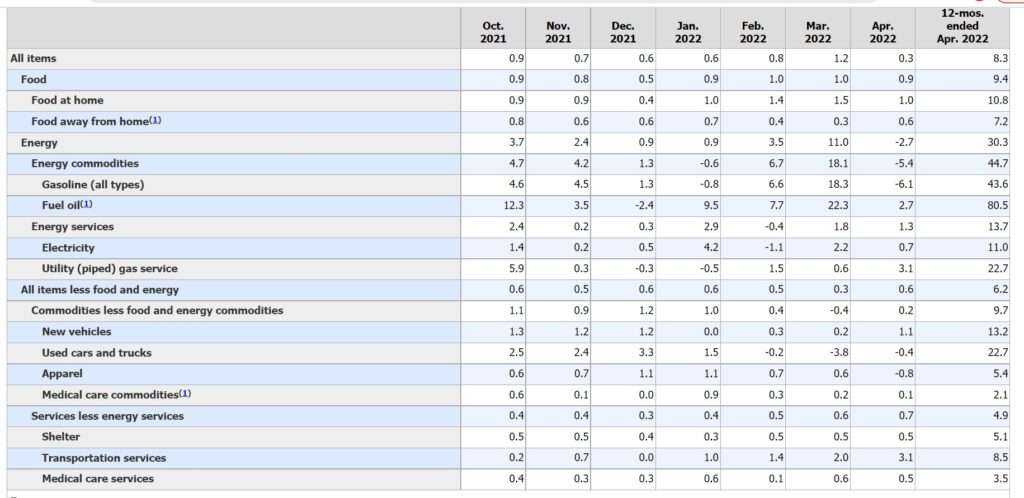
Prices throughout the economy have increased by 8.3 percent over the past year and inflation continues chugging along at near 40-year highs despite some easing of prices for gas and other fuels.
Data released Wednesday morning by the Department of Labor show that annualized inflation fell from 8.5 percent in March to 8.3 percent in April, marking the first time in eight months that the country's most important inflation indicator declined, even if only slightly. Prices rose by an average of 0.3 percent in April, down significantly from March's 1.2 percent increase that drove annual inflation rates to a 40-year high.
But anyone tempted to view April's lower monthly inflation rate as good news ought to look a little deeper.
The slightly less terrible inflation rate for April is largely the result of falling gas and energy prices—even though gas prices remain 43 percent higher than they were a year ago and energy prices are up 30 percent in the past 12 months. That those prices decreased in April seems more likely to be a reaction to the increases seen in March than any systemic stabilization of inflation.
Meanwhile, prices for food and housing continued to increase at about the same rate as in previous months. Food prices were up 0.9 percent in April after rising by 0.9 percent, 1 percent, and 1 percent in the past three months. All prices excluding food and energy increased by 0.6 percent in April, double the overall monthly rate. Services outside of the energy sector saw inflation of 0.7 percent.
In short, the fundamental economic process that has been driving inflation for much of the past year—too much money chasing the same number of goods—remains solidly in place. Russia's war in Ukraine caused a temporary shock in energy prices that made March's report an outlier, but inflation remains, as always, a monetary phenomenon.
Anyone who actually has to balance a household budget and pay bills is likely to take little comfort from the knowledge that inflation is running a whole two-tenths of a percent lower than the highest mark since the early 1980s. And there is likely to be more economic pain to come, as the Federal Reserve has already raised interest rates to combat inflation and indicated that it plans to do so again. Rising interest rates will pull some excess cash out of the economy, hopefully slowing inflation, but also make credit and loans more expensive and generally slow economic growth.
This is the inflation story to worry about: core services inflation has increased for four straight months. We're getting the much predicted/hoped for reprieve on goods price increases but services matter 5X in the computation of the CPI. pic.twitter.com/oPyYNbkusE
— Jason Furman (@jasonfurman) May 11, 2022
How the Biden administration greets April's inflation data will be telling. The White House was eager to pin March's runaway price hikes on Russian President Vladimir Putin, mostly to distract from the ways that President Joe Biden's own policies had cranked the economy to 11 and helped trigger inflation in the first place.
On Wednesday morning, the White House issued a fact sheet once again blaming Russia for higher prices and promising to take a series of actions to help American farmers, including providing higher crop insurance payments and doubling domestic subsidies for fertilizer production. That sounds a lot like last month's plan to fix high and rising gas prices by ramping up production of ethanol—an overly complicated scheme that's unlikely to produce immediate results, possibly even worsening inflation by countering the signals that higher prices send to the rest of the market.
But there are steps Biden could take to immediately ease inflation, at least in some small ways. He could remove tariffs, which increase the price of imported goods for American businesses and consumers. He could remove barriers to legal immigration so that more workers could help ease supply chain snafus that contribute to higher prices. He could suspend the Jones Act, which adds to the cost of shipping just about anything from one American port to another.
So far, there's been no indication from the White House that it is serious about combating inflation. If Biden uses April's inflation numbers as an opportunity for a victory lap, it will only confirm how clueless the administration truly is. America is a long way from having inflation back under control.
The post Inflation Still Soaring at 8.3 Percent as Food, Housing, and Services Keep Getting More Expensive appeared first on Reason.com.








